Short Book Reviews
Hanna Kryszewska, Poland
Hanna Kryszewska is a teacher, teacher trainer, trainer of trainers. She is a senior lecturer at the University of Gdańsk, and EU Teacher Training College where she trains pre-service teachers. She is co-author of resource books: Learner Based Teaching, OUP, Towards Teaching, Heinemann, The Standby Book, CUP, Language Activities for Teenagers, CUP, The Company Words Keep, DELTA Publishing, and a course book series for secondary schools: ForMat, Macmillan. She is also co-author of a video based teacher training course: Observing English Lessons. Hania is a Pilgrims trainer and editor of HLT Magazine.
E-mail: hania.kryszewska@pilgrims.co.uk
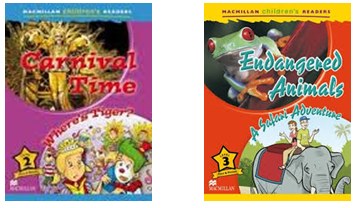
Macmillan Children’s Readers. Fact & Fiction. Level 1-4. Different authors, photographers and illustrators. Macmillan. (2013). e.g. Monkeys ISBN 978-0-230-44367-9, pp 23., Lights, Camera, Action, ISBN 978-0-230-44370-9, pp.31. This new six level series of readers is intended for young learners aged 7-10. The topics I have had a chance to look at include: Food, Food, Food, We Love Toys, Monkeys, Carnival Time, Endangered Animals, Kings and Queens, Elephants, and Lights, Camera, Action! . Overall the books follow a similar pattern; first come facts with realistic photography, then a comic strip, and finally some language activities and a picture dictionary. However, at higher levels there are also some reading comprehension exercises. The language i.e. grammar and vocabulary are carefully graded. Certain grammar structures and lexical items are introduced in the first part of the book, then reinforced in the comic story and practised in the activity section. The books are ideal for lessons supplementing the coursebook or introducing CLIL. This is a very good combination as young learners are interested in learning English but above all they are hungry to learn about the surrounding world. The readers tap into this need perfectly and they are also ideal for a reading corner. As the books have been written by different authors and the artwork comes from different illustrators, they are not repetitive from title to title. Each one you pick up feels fresh and different. The teachers get a lot of support; there are additional audio downloads and teacher resources which are available at:
www.macmillanyounglearners.com/readers
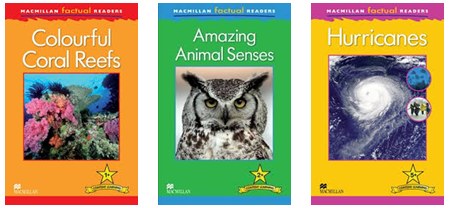
Macmillan Factual Readers. Content Learning. Level 1-6. Different authors. Macmillan. (2013). e.g. Colourful Coral Reefs ISBN 978-0-230-44201-7, pp32., Rivers, ISBN 978-0-230-43224-6, pp.32. This new six level series of readers is intended for young learners aged 10+. The 20 titles I have had a chance to look at include: Baby Animals, What Animals Eat, Firefighters, Spiders, The Most Dangerous. Overall the books follow a similar pattern; first come factual texts and then a glossary section. The factual texts are accompanied by realistic photography in National Geographic style. The language, i.e. grammar and vocabulary are structured but the facts are sound and the books follow a true CLIL line. The books are ideal for lessons supplementing the coursebook or introducing CLIL. Young learners are interested in learning English but above all they are hungry to learn about the surrounding world. The readers tap into this need perfectly and they are also ideal for a reading corner. The teachers can also use audio downloads and teacher resources which are available at:
www.macmillanyounglearners.com/readers
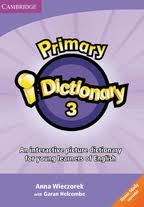
Primary i Dictionary 3. An interactive picture dictionary for young learners of English. A. Wieczorek with G. Halcombe. Cambridge University Press (2011). ISBN 978-0-521-17587-6. The dictionary I looked at is part 3 of a three part series of dictionaries designed for children preparing for the YLE tests; the one in question is intended for the Flyers level. The aim of this interactive picture dictionary is to build up the young learners’ vocabulary, teach them how to use a dictionary ( learner training) and help them make friends with ICT resources. (The dictionary comes in British and American English versions). When you run the DVD-ROM you see the menu:
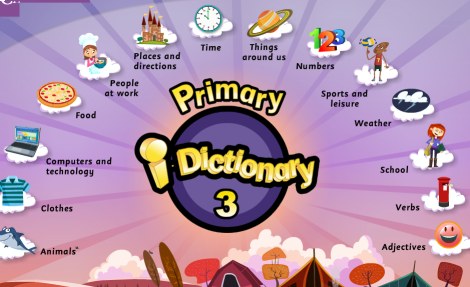
When you click on the option of your choice, e.g. ‘people at work’ you can choose from the following options:
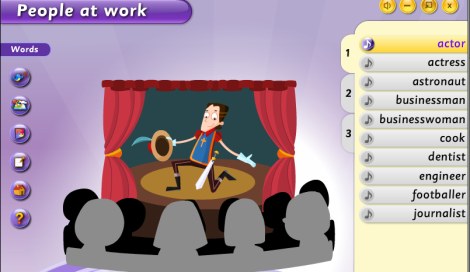
Then if you choose ‘actor’ you see the picture, if you choose ‘astronaut’ you see a picture of one. Great visual input. Then on the left-hand side you can choose: song, story, game, worksheets, home, and help. I clicked on the song but what the authors call songs are in fact chants. As for the stories are they are clever and fun but they contain a lot of grammar e.g. for ‘people at work’ simple past tense, want to be, I will see, what about being…, could I be, simple present of the verb ‘to be’, want to…, have to, going to, simple present tense, good at doing smith. etc. Very dense. So make sure your learners are ready for the story grammar wise.
When I clicked on a game I got this task to do ( with nice sound effects). It is a bit challenging but I suppose with a bit of perseverance it can be done; good for practising spelling and reading…
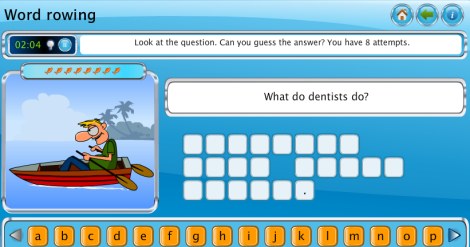
I believe the resource is great but teachers need to assist the learners in using the dictionary... so that it is real fun!
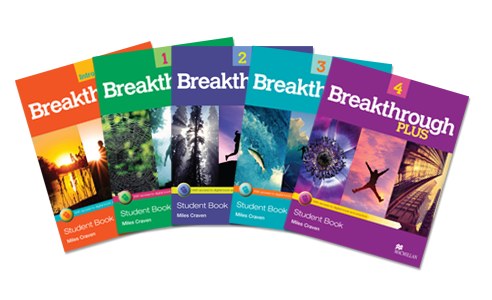
Breakthrough Plus 1-4. M. Craven. Macmillan. (this edition 2013). ISBN for Breakthrough Plus 1978-0-230-43813-2, pp 119. This five part course is intended for young adult and adult learners of English, although just flicking through the books I get the impression that the artwork may not be suitable for some adult, more serious students. However, I am sure many young learners will love the design of the books and their approach. The course is a new version of a course published in 2008, however, I cannot compare the two versions. Clearly this course has an up-to-date content and focuses on communication skills. No doubt the texts and activities will motivate students to learn English. The coursebooks come with Digibooks with on-screen versions of the student books with integrated audio and video, and additional interactive practice activities. Teachers will certainly appreciate the CD-ROM test generator.
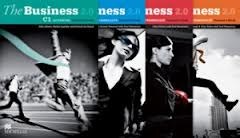
The Business 2.0. J. Allison, ( J. Townend) with Paul Emerson. (this edition 2013) Macmillan. ISBN for The Business 2.0 B2 Upper Intermediate 978-0-230-43796-8, pp159. This four part course which I have had a chance to look at is based on the original very successful earlier edition from 2008. It is intended for learners of English who need to master the fundamentals and skills they need to succeed in the competitive international business environment. The course covers business fundamentals with an overview of how the business world works and addresses many business related topics such as: personal development, service, sales and marketing, finance and enterprise. The structure of the books is very flexible which means that the teacher can dip in and out of them, in effect creating their own course. The progression in the course had got the right pace and the texts are interesting and up to date. The coursebooks come with eWorkbooks which the learners can access on their own to get extra practice, download word lists or take tests, just to name a few of the features. Usually coursebooks focus on the four language skills. The authors introduce and practice the fifth skill - emotional intelligence – vital for a successful professional. The books are aesthetically pleasing and the layout and design will appeal to an aspiring professional
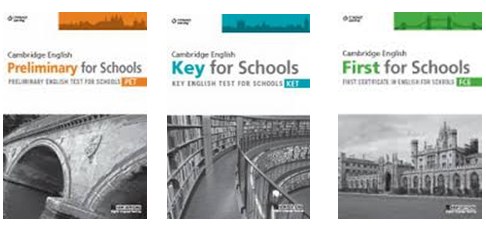
Cambridge English Preliminary for Schools. Preliminary English Test for Schools PET. (2013)CENGAGE Learning. New Editions. ISBN 978-1-4080-6152-7, pp200.,
Cambridge English Key for Schools. Key English test for schools. KET. (2013)CENGAGE Learning. New Editions. ISBN 978-1-4080-6155-8, pp184., and Cambridge English for Schools. First Certificate in English for Schools. FCE. (2013)CENGAGE Learning. New Editions. ISBN 978-1-4080-6149-7, pp200. These three titles belong to a series of test books preparing for particular Cambridge exams. Like other publications of this kind they aim at making the students familiar with the exam format and provide ample practice. The tips sections contain advice on how to approach each kind of task and how to improve exam performance. At the end of the books there are vocabulary lists of lexical items used in each test, which is very useful. In the KET and FCE test books the publisher or editor is extremely generous if not wasteful with space as there are many half or even less filled pages (e.g. only 8 lines of text on an A4 page), quite a shame if we think of the trees that have to be cut to print books…
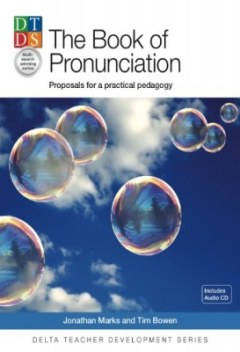
The Book of Pronunciation. J. Marks and T. Bowen(2012)DELTA. ISBN978-1-905085-70-5, pp176. The book has been published in the much liked and very popular DELTA Teacher Development Series. It contains over one hundred activities which provide ideas how to incorporate pronunciation into English language classes. The activities are a wealth if ideas and broaden the teacher’s repertoire of pronunciation activities for their lessons. They help the learners to become more confident about their pronunciation and to be more intelligible. Like all DELTA resource books in the series it falls into three parts. In Part A the authors answer a number of questions teachers usually ask or might ask about teaching pronunciation and its role in language teaching. Then follows an exhaustive description of the types of sounds we need to teach ( “From a mouthful of air to stream of sound” after W.B. Yeats), sounds in connected speech, the role of intonation, and the relationship between spelling and sounds. In Part B you will find a wealth of excellent ideas to be used in connection with the coursebook or transcripts from the coursebook you use with your class. There are also activities that go with the texts written by the authors. These are also recorded on a CD which comes with the book, needless to say recorded by native speakers. Finally, Part C offers further development for the teacher who wants more. There is more on pronunciation in the form of quizzes and other activities, more about the learners and action research, and finally more thoughts on teaching pronunciation. Highly recommended.

Please check the Methodology and Language for Kindergarten Teachers course at Pilgrims website.
Please check the Methodology and Language for Primary Teachers course at Pilgrims website.
Please check the Methodology and Language for Secondary Teachers course at Pilgrims website.
Please check the Teaching Advanced Students course at Pilgrims website.
Please check the Certificate in Teaching Business English Level 1 course at Pilgrims website.
Please check the Pronunciation course at Pilgrims website.


|